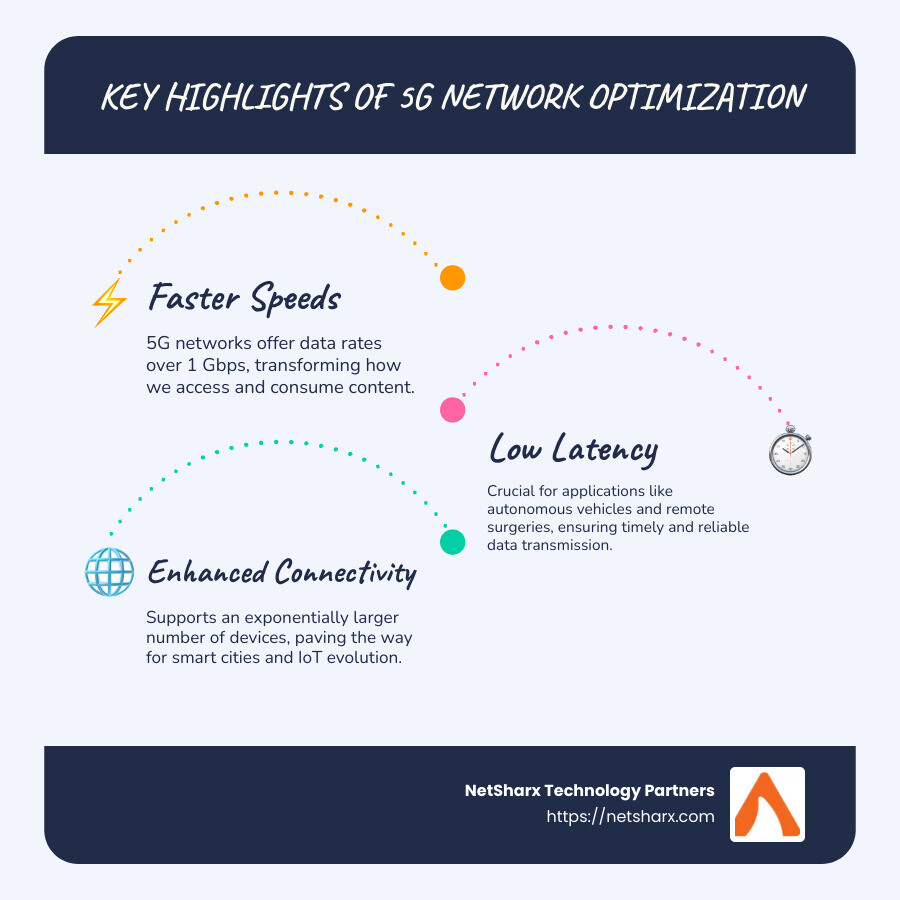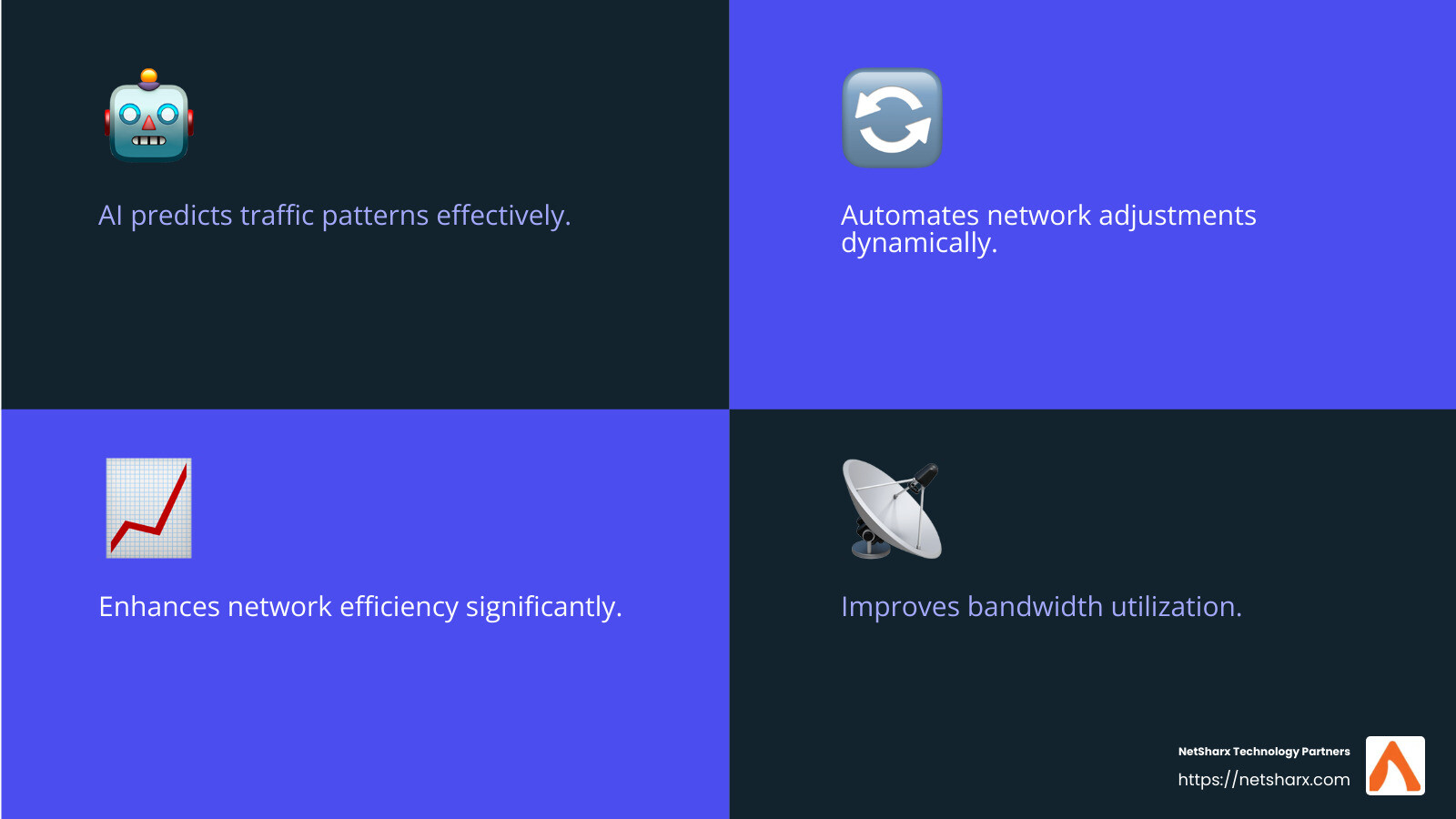5g network optimization is the key to open uping the true potential of 5G networks. As 5G technology unfolds, it promises faster speeds, significantly lower latency, and unparalleled connectivity. Imagine streaming high-definition video with seamless clarity, experiencing immersive AR/VR applications in real-time, and supporting a massive number of connected devices—all thanks to the power and efficiency of 5G.
Key Highlights of 5G Network Optimization:
- Faster Speeds: 5G networks offer data rates over 1 Gbps, changing how we access and consume content.
- Low Latency: Crucial for applications like autonomous vehicles and remote surgeries, ensuring timely and reliable data transmission.
- Improved Connectivity: Supports an exponentially larger number of devices, paving the way for smart cities and IoT evolution.
As our digital world rapidly grows, optimizing 5G networks ensures that changes translate into tangible benefits, solving the challenges faced by enterprises globally. It’s not just about evolution; it’s about preparing for a significant change.
I’m Ryan Carter, founder and CEO of NetSharx Technology Partners. With expertise in 5g network optimization, we’ve been instrumental in helping enterprises transition to advanced network solutions smoothly and efficiently.
Understanding 5G Network Optimization
When it comes to 5G, optimization is the name of the game. It’s not just about having a faster network; it’s about making sure that network is the best it can be, everywhere it needs to be.
Network Quality and Coverage
5G networks promise incredible speed and reliability, but these features are only as good as the network’s quality and coverage. Network quality refers to the consistency and reliability of the connection you experience. This means fewer dropped calls, smoother video streaming, and more reliable connections for critical applications like remote surgeries or autonomous vehicles.
Coverage is another crucial aspect. It’s about ensuring that 5G networks reach as many people and devices as possible, from busy city centers to remote rural areas. This is where technologies like beamforming and massive MIMO come into play, enhancing signal strength and coverage.
The Importance of 5G Optimization
Why is 5G optimization so critical? Because it ensures that these networks deliver on their promises. By using advanced tools and techniques, network providers can identify and fix issues before they affect users. This means better service for everyone, from individual consumers to large enterprises.
Tools and Techniques for Optimization
5G NR (New Radio) optimization tools give operators a detailed view of network performance. These tools help in:
- Identifying Irregularities: Spotting problems like weak signals or high latency.
- Ensuring High Capacity: Making sure the network can handle a massive number of connections.
- Verifying Technologies: Checking that technologies like beamforming and massive MIMO are working as they should.
By optimizing 5G networks, operators can minimize quality issues and ensure high capacity, paving the way for future innovations in smart cities, IoT, and beyond.
The Role of AI in Optimization
Artificial Intelligence (AI) plays a significant role in 5G optimization. It helps by predicting traffic patterns, dynamically managing resources, and automating network adjustments. This means reduced latency, better bandwidth utilization, and overall improved network efficiency.
As we continue to harness the power of 5G, network optimization will remain crucial in delivering the high-quality, reliable connectivity that users expect. This is not just about keeping up; it’s about staying ahead in a rapidly evolving digital landscape.
The Role of Edge Computing in 5G Optimization
Edge computing is a game-changer for 5G network optimization. It brings data processing closer to where the data is generated, improving both speed and efficiency.
Boosting Network Performance
One of the biggest advantages of edge computing is its ability to improve network performance. By processing data at the edge of the network, near the source of data generation, it reduces the distance data needs to travel. This means faster data processing and quicker response times for applications.
Consider this: In a traditional network setup, data might travel hundreds of miles to a central server for processing. With edge computing, that data can be processed in a local data center or even at a base station nearby. This drastically cuts down on latency, or the delay in data transmission.
For example, edge computing can be used to deliver ultra-low latency for applications like augmented reality (AR) and the Internet of Things (IoT). This setup allows 5G networks to offer a superior experience with minimal lag and high performance.
Efficient Data Processing
Edge computing also plays a crucial role in efficient data processing. It allows networks to handle large amounts of data locally, alleviating the load on central servers. This is especially important for bandwidth-intensive applications like smart cities and IoT devices, which generate vast amounts of data every second.
By processing this data at the edge, networks can better manage bandwidth and ensure smooth operation. This is vital for applications that require real-time data analysis, such as autonomous vehicles or remote surgeries.
Multi-Access Edge Computing (MEC)
Multi-Access Edge Computing (MEC) is another key component in optimizing 5G networks. MEC integrates edge computing with telecom infrastructure, moving data processing closer to mobile users. This not only reduces latency but also lowers operational costs for telecom operators by offloading tasks from central data centers.
For instance, telecom companies using MEC can support bandwidth-heavy, low-latency applications more efficiently. This integration results in improved user experiences and optimized resource utilization.
Overcoming Challenges
Implementing edge computing in 5G networks does come with challenges. These include integrating edge nodes with existing infrastructure and managing distributed data. Ensuring robust security at the network’s edge is also critical.
To address these challenges, telecom operators are developing standardized frameworks for edge computing deployments. Collaborations and partnerships among technology firms are also paving the way for smoother edge computing integration.
As 5G networks continue to expand, edge computing will be essential for optimizing performance. By bringing data processing closer to users, it ensures that 5G networks can meet the growing demands of both consumers and businesses.
Next, let’s explore the key strategies for optimizing 5G networks and how they contribute to delivering high-quality, reliable connectivity.
Key Strategies for 5G Network Optimization
Optimizing a 5G network involves several strategies aimed at improving speed, reducing latency, and supporting increased bandwidth. These strategies ensure that 5G networks deliver on their promise of high-quality, reliable connectivity.
Speed Improvement
Speed is one of the most talked-about features of 5G. With data rates exceeding 1 Gbps, 5G networks support applications like virtual reality and high-definition video streaming. To achieve these speeds, operators use technologies like beamforming and massive MIMO (Multiple Input, Multiple Output). These technologies focus the signal towards users, rather than broadcasting it broadly, thus enhancing speed and efficiency.
Additionally, network slicing plays a crucial role. By creating virtual slices of the network, operators can allocate resources more efficiently, ensuring that high-demand services get the bandwidth they need without affecting other applications.
Latency Reduction
Low latency is critical for applications like autonomous vehicles and remote surgeries, where even a slight delay can have significant consequences. 5G networks aim to reduce latency to as low as 1 millisecond. This is achieved through edge computing, which processes data closer to the user, minimizing the time it takes for data to travel back and forth.
Another method is using hierarchical network optimization. This approach involves creating reliable point-to-point connections, enabling faster retransmission if data packets are lost. This ensures smoother and quicker data flow, reducing latency.
Bandwidth Support
Supporting a massive number of devices is a hallmark of 5G. With the capability to connect 10-100 times more devices than previous technologies, 5G networks must efficiently manage bandwidth. Techniques like network slicing and Multi-Access Edge Computing (MEC) help manage the load by distributing data processing and ensuring that bandwidth-heavy applications get the resources they need.
Moreover, energy efficiency is a key focus. By implementing energy-efficient backhaul and using small cells, networks can support a large number of connections while minimizing power consumption.
These strategies work together to ensure that 5G networks are not only fast and reliable but also capable of handling the growing demands of modern digital applications. As we continue to explore the potential of 5G, understanding and implementing these optimization strategies will be crucial for telecom operators.
Next, let’s tackle some frequently asked questions about 5G network optimization to further clarify how these strategies come into play in real-world scenarios.
Frequently Asked Questions about 5G Network Optimization
What is 5G optimization?
5G optimization refers to enhancing the performance and efficiency of 5G networks. This involves improving network quality and ensuring high capacity to support numerous connected devices. Technologies like 5G NR (New Radio) are at the core of this process, helping to deliver faster speeds and lower latency. By using tools that provide a comprehensive view of network quality and coverage, operators can minimize issues and maximize the capacity of their networks.
How do I optimize my 5G signal?
To optimize your 5G signal, consider these simple steps:
-
Repositioning: Place your device closer to windows or open spaces to reduce obstacles like walls or furniture that can weaken the signal.
-
Avoid Obstacles: Ensure there are minimal physical barriers between your device and the signal source. Metallic objects and thick walls can significantly degrade signal quality.
-
Use External Antennas: If available, external antennas can boost your device’s signal reception, especially in areas with weak coverage.
-
Check Network Settings: Ensure your device is set to automatically connect to the best available network mode, such as SA (Standalone) or NSA (Non-Standalone), depending on coverage in your area.
What is the best network mode for 5G?
The choice between SA mode and NSA mode depends on your needs and network availability:
-
SA Mode: This mode uses a pure 5G core network, offering benefits like lower latency and advanced network functions. It’s ideal for applications requiring ultra-reliable and low-latency communications.
-
NSA Mode: This mode leverages existing 4G infrastructure, providing a more gradual transition to 5G. It is suitable for areas where 5G coverage is still expanding, ensuring broader connectivity.
Selecting the right mode ensures that you get the best performance from your 5G network, aligning with your specific requirements and the available infrastructure.
These insights into 5G optimization highlight the importance of strategic adjustments and settings to ensure optimal network performance. Understanding these elements helps users and operators make informed decisions to improve their 5G experience.
Conclusion
As we accept the future of connectivity, NetSharx Technology Partners stands ready to guide you through the complexities of 5G network optimization. Our expertise lies in crafting custom solutions that meet your unique needs and drive technology change in your organization.
When connectivity is key, our unbiased approach ensures you receive the best possible service. We leverage an extensive network of providers to deliver custom solutions that improve your network’s performance and efficiency. Whether you need help with cloud, network, cybersecurity, or communications, our team is here to simplify your technology change journey.
Our commitment to technology change is unwavering. We understand that each business has its own set of challenges and opportunities. That’s why we focus on providing solutions that not only meet today’s demands but also prepare you for tomorrow’s possibilities.
At NetSharx Technology Partners, we believe in making technology work for you. Let us help you open up the full potential of your 5G network and stay ahead in this rapidly evolving digital landscape.
For more information on how we can assist with your network optimization needs, visit our Network Connectivity page. Let’s transform your technology together.





